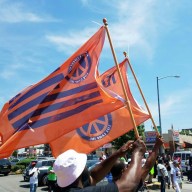The opening day schedule is somewhat abbreviated, however —…
By Alex Berger
Attention all you Yankees and Mets fans: Your pining-for-baseball days soon will be over. On April 1 (April Fool’s Day!) the new 2001 season, currently in the on-deck circle, will commence.
The opening day schedule is somewhat abbreviated, however — only one game. It pits the Texas Rangers against the Toronto Blue Jays. Don’t fret however, because April 2 is your big day. All the other teams, including the Yanks and the Mets, will see action.
Baseball is an old and cherished sport which has been played as far back as our Civil War in the 1860s and earlier. Perhaps many young American lives in that war would have been spared if the two sides chose up teams and pitched baseballs instead of cannon balls at one another. Hmmm! A thought just crossed my brow. In the interest of peace, perhaps we should challenge Iraq, China, and any other adversary, to meet us on the field of honor — the baseball field. Thoughts of baseball, and not war, would be on everybody’s mind, and we all would live happily ever after.
A question – Did you know that baseball is the only sport in which the ball is always in the possession of the team on defense, and that the offensive team can score without ever touching the ball? All right, so you knew the answer to that one. Well, what about these other baseball toughies?
1. There are seven ways a baseball player can legally reach first base without getting a hit. A walk is one way. What are the other six?
2. How is it possible for a pitcher to make four or more strike-outs in one inning? (The answers appear below).
Recently I received a letter from a reader who asked me to explain the game of baseball to her. Imagine that! I just couldn’t believe that, in this day and age, this lady did not know the simple rules of simple baseball. I guess she must come from New Jersey. I’m glad that she asked me, however.
She must have known that I am a baseball maven. In fact, George Steinbrenner took his first lessons from me. I taught him so well that following my final class, he immediately went out and bought the Yankees. So, as a public service, I will here and now explain the wonderful game to her. Take notes, my dear baseball-deficient lady: I might quiz you later.
You have two sides — one out in the field and one in. Each player who is on the side that’s in, goes out and when he is out, he comes in. And the next player goes in until he is out. When three men are out, the side that’s out comes in. Then the side that has been in goes out and tries to get those coming in, out. Sometimes you get players in and not out. When both sides have been in and out nine times including the not-outs….. that is the end of the game. Got it? Good!
Ah, baseball. Whenever a new season rolls around, I think of those wonderful, long-gone players I idolized in my childhood. Many a day back then, I got into many a fight arguing that my favorite players were better than my friend's players. Yes, Duke Snider of the Brooklyn Dodgers was a better player than Mickey Mantle of the Yankees and Willie Mays of the New York Giants put together, I said, but now being older and wiser, I see the error of my ways.
But a question keeps hounding me to this very day. Is the outfield of Babe Ruth- Tris Speaker-Ty Cobb of the 1920s, better than the outfield of Ted Williams-Joe DiMaggio-Stan Musial of the ’40s, or the outfield of Mickey Mantle-Willie Mays-Hank Aaron of the ’4Os? And, is any current trio of outfielders better than any of those ’20s and ’40s outfielder combinations?
I guess the answer is in the eye of the beholder — we tend to choose the era of our youth.
A personal baseball story I love to relate happened during my early teenage years, when I was not only a rabid baseball fan, but also a baseball gambler. My best friend “Hack” and I would frequent a sleazy pool room, which was situated atop a frankfurter stand on the corner of Delancy and Essex streets on the Lower East Side. We were both poor as synagogue mice, but we were always able to accrue enough gambling money from our meager earnings working after-school as delivery boys.
One day, Hack said that he studied the pitchers, and he came up with a sure bet. We should place our money on the Philadelphia Athletics (now the Oakland A’s) who were playing a Sunday double-header in Philadelphia. (Regrettably, teams do not play double-headers as often anymore). “They should win both games,” Hack predicted. “The A’s are at home and are pitching their ace pitchers. We cannot lose.”
So I took the best part of my weekly earnings of $5 and, along with Hack’s $5 (that was big money in those days, especially for two teenage boys), presented it to the bookie. Then Hack further suggested that we travel to Philadelphia to cheer the A’s on in person. “Why not?” I declared, and we were soon on a bus headed for Philadelphia.
We entered the park only to watch our team lose, not one, but BOTH games of the double-header.
Dejectedly, we bused home, and arrived in New York City in the wee hours of the morning sans our $5, sans sufficient sleep, and with parents who were worried all night. The moral of that story is simple — never take baseball advice from any guy nicknamed Hack.
Here are the answers I promised: 1. Batter hit by a pitch; passed ball; catcher interference; catcher drops third strike; fielder’s choice; and being designated a pinch runner. 2. If the catcher drops a called third strike, and doesn’t throw the batter out at first base, the runner is safe.
Reach Times-Ledger columnist Alex Berger by e-mail at aberger.3@nyc.rr.com), or call 229-0300, Ext. 139.



























